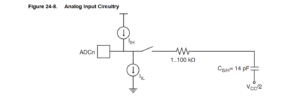This article documents the charge cycle of a NanoVNA-H4 from fully discharged to charged.
The DUT is probably a ‘standard’ H4, but with Chinese sourced produce, you never, never know.
The original battery fitted to the NanoVNA-H v4.3 is a 804050 (8.0x40x50mm) 2000mAh LiPo pouch cell (1S) with protection board.
The charger chip is a TP4056, and it would appear to be limited by Rprog to about 0.75A (which includes the current drawn by the working NanoVNA-H4) (though the circuit employed would appear to tweak that limit between VNA on and off conditions with R44). The TP4056 is simply a charger chip, it will not prevent over-discharge of the cell so it is wise to use a cell with protection board (as originally supplied on the DUT).

Above is a plot of the calibrated battery voltage reported by the NanoVNA-H4. Continue reading NanoVNA-H4 – battery charge from discharged
Last update: 4th June, 2022, 7:07 AM







